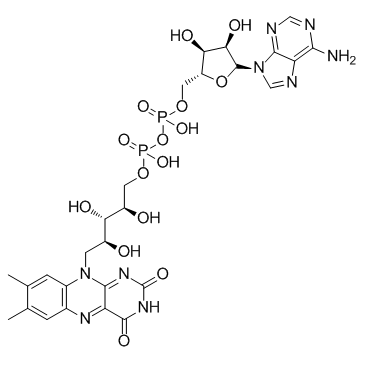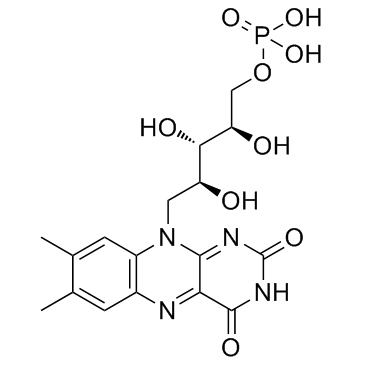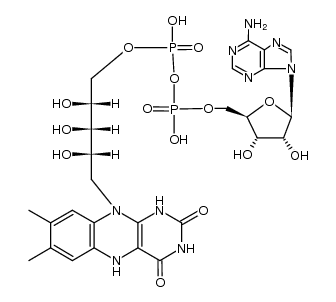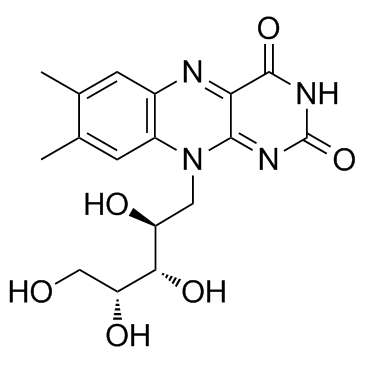146-14-5
| Name | fad |
|---|---|
| Synonyms |
Adenosine 5'-(Trihydrogen Diphosphate) 5'®5'-Ester With Riboflavine
Riboflavine 5'-(Trihydrogen Diphosphate) 5'®5'-Ester with Adenosine Riboflavine 5'-Adenosine Diphosphate Flavin adenin dinucleotide FLAVIN ADENINE DINUCLEOTIDE [(2R,3S,4R,5R)-5-(6-Amino-9H-purin-9-yl)-3,4-dihydroxytetrahydro-2-furanyl]methyl (2R,3S,4S)-5-(7,8-dimethyl-2,4-dioxo-3,4-dihydrobenzo[g]pteridin-10(2H)-yl)-2,3,4-trihydroxypentyl dihydrogen diphosphate (non-preferred name) Flavine Adenine 1H-Purin-6-amine Flavin Dinucleotide EINECS 282-733-8 Riboflavine 5'-Ester with Adenosine 5'-Diphosphate [(2R,3S,4R,5R)-5-(6-Amino-9H-purin-9-yl)-3,4-dihydroxytetrahydrofuran-2-yl]methyl (2R,3S,4S)-5-(7,8-dimethyl-2,4-dioxo-3,4-dihydrobenzo[g]pteridin-10(2H)-yl)-2,3,4-trihydroxypentyl dihydrogen diphosphate (non-preferred name) [(2R,3S,4R,5R)-5-(6-Amino-9H-purin-9-yl)-3,4-dihydroxytetrahydro-2-furanyl]methyl (2R,3S,4S)-5-(7,8-dimethyl-2,4-dioxo-3,4-dihydrobenzo[g]pteridin-10(2H)-yl)-2,3,4-trihydroxypentyl dihydrogen diphosphate |
| Description | Flavin Adenin Dinucleotide is a redox cofactor, more specifically a prosthetic group of a protein, involved in several important enzymatic reactions in metabolism. |
|---|---|
| Related Catalog | |
| Target |
Human Endogenous Metabolite |
| In Vitro | Poly(Flavin Adenin Dinucleotide, FAD) characterized by an additional polymer-type redox reaction is a highly effective electrocatalyst for NADH oxidation: operating at the lowest potentials reported for NADH transducers (0.00 V, pH 7.4), poly(FAD) is characterized by the electrochemical rate constant of 1.8 ± 0.6×10-3 cm/s, which is at the level of the NADH mass-transfer constant. Poly(FAD)-modified electrodes are characterized by the dramatically improved stability and, is the most advantageous NADH transducers for analytical chemistry[2]. |
| In Vivo | Flavin Adenin Dinucleotide (2 mg/kg, i.v.) significantly cancels chlorpromazine (CPZ)-induced decrease in ventricular fibrillation threshold (VFT). Flavin Adenin Dinucleotide cancels the effect of CPZ on canine heart mitochondria. After injection of Flavin Adenin Dinucleotide, the dogs show a transient hypotension within 10 min, then their blood pressures recover to the initial level. Flavin Adenin Dinucleotide also prevents mitochondrial dysfunction induced by chlorpromazine[1]. |
| Animal Admin | Dogs[1] The dogs are divided into 3 groups and they are received the following treatments. Each group consists of 6 dogs. Dogs in group I as control, are given 2 mL/kg of physiological saline by intravenous injection. Ten min after the start of the first injection, another dose of saline, 1 mL/kg, is injected intravenously. Dogs in group II are given i.v. 2 mL saline/kg. Ten min afterwards, 1 mg chlorpromazine(CPZ)/kg is injected. Dogs in group III are given i.v. Flavin Adenin Dinucleotide, 2 mg/kg. Ten min later, they are given CPZ, 1 mg/kg. All solutions is administrated in 1 min or 2. Blood samples are taken before and 10, 20, 30, and 40 min after the intravenous injection of saline (groups I and II) or Flavin Adenin Dinucleotide (group III). Serum K+ and blood pH are also measured. Heart rate, blood pressure and ventricular fibrillation threshold (VFT) of each dog are recorded at the same intervals[1]. |
| References |
| Density | 2.1±0.1 g/cm3 |
|---|---|
| Molecular Formula | C27H33N9O15P2 |
| Molecular Weight | 785.550 |
| Exact Mass | 785.157104 |
| PSA | 382.55000 |
| LogP | -2.93 |
| Index of Refraction | 1.850 |
| Storage condition | −20°C |
| Stability | Stable. Incompatible with strong oxidizing agents. |
Synonym: Adenine-riboflavin dinucleotide; Flavine Adenosine Diphosphate; Isoalloxazine-adenine dinucleotide; FAD. SECTION 2 - COMPOSITION, INFORMATION ON INGREDIENTS
Risk Phrases: None Listed. SECTION 3 - HAZARDS IDENTIFICATION EMERGENCY OVERVIEW The toxicological properties of this material have not been fully investigated. Potential Health Effects Eye: May cause eye irritation. Skin: May cause skin irritation.
Ingestion: May cause irritation of the digestive tract. The toxicological properties of this substance have not been fully investigated. Inhalation: May cause respiratory tract irritation. The toxicological properties of this substance have not been fully investigated. Chronic: No information found. SECTION 4 - FIRST AID MEASURES Eyes: Flush eyes with plenty of water for at least 15 minutes, occasionally lifting the upper and lower eyelids. Get medical aid immediately. Skin: Get medical aid. Flush skin with plenty of water for at least 15 minutes while removing contaminated clothing and shoes. Wash clothing before reuse. Ingestion: If victim is conscious and alert, give 2-4 cupfuls of milk or water. Never give anything by mouth to an unconscious person. Get medical aid immediately. Inhalation: Remove from exposure and move to fresh air immediately. If not breathing, give artificial respiration. If breathing is difficult, give oxygen. Get medical aid. Notes to Physician: Antidote: None reported. SECTION 5 - FIRE FIGHTING MEASURES General Information: As in any fire, wear a self-contained breathing apparatus in pressure-demand, MSHA/NIOSH (approved or equivalent), and full protective gear. During a fire, irritating and highly toxic gases may be generated by thermal decomposition or combustion. Extinguishing Media: Use water spray, dry chemical, carbon dioxide, or appropriate foam. SECTION 6 - ACCIDENTAL RELEASE MEASURES General Information: Use proper personal protective equipment as indicated in Section 8. Spills/Leaks: Clean up spills immediately, observing precautions in the Protective Equipment section. Sweep up or absorb material, then place into a suitable clean, dry, closed container for disposal. Avoid generating dusty conditions. Provide ventilation. SECTION 7 - HANDLING and STORAGE Handling: Wash thoroughly after handling. Remove contaminated clothing and wash before reuse. Use with adequate ventilation. Minimize dust generation and accumulation. Avoid contact with eyes, skin, and clothing. Keep container tightly closed. Avoid ingestion and inhalation. Storage: Keep container closed when not in use. Store in a tightly closed container. Store in a cool, dry, well-ventilated area away from incompatible substances. SECTION 8 - EXPOSURE CONTROLS, PERSONAL PROTECTION Engineering Controls: Use adequate ventilation to keep airborne concentrations low. Exposure Limits CAS# 146-14-5: Personal Protective Equipment Eyes: Wear appropriate protective eyeglasses or chemical safety goggles as described by OSHA's eye and face protection regulations in 29 CFR 1910.133 or European Standard EN166. Skin: Wear appropriate protective gloves to prevent skin exposure. Clothing: Wear appropriate protective clothing to prevent skin exposure. Respirators: Follow the OSHA respirator regulations found in 29 CFR 1910.134 or European Standard EN 149. Use a NIOSH/MSHA or European Standard EN 149 approved respirator if exposure limits are exceeded or if irritation or other symptoms are experienced. SECTION 9 - PHYSICAL AND CHEMICAL PROPERTIES Physical State: Solid Color: Not available. Odor: Not available. pH: Not available. Vapor Pressure: Not available. Viscosity: Not available. Boiling Point: Not available. Freezing/Melting Point: Not available. Autoignition Temperature: Not available. Flash Point: Not available. Explosion Limits, lower: N/A Explosion Limits, upper: N/A Decomposition Temperature: Solubility in water: Specific Gravity/Density: Molecular Formula: C27H31N9Na2O15P2 Molecular Weight: 829.1955 SECTION 10 - STABILITY AND REACTIVITY Chemical Stability: Stable under normal temperatures and pressures. Conditions to Avoid: Incompatible materials, dust generation, strong oxidants. Incompatibilities with Other Materials: None reported. Hazardous Decomposition Products: Carbon monoxide, oxides of nitrogen, oxides of phosphorus, irritating and toxic fumes and gases, carbon dioxide. Hazardous Polymerization: Will not occur. SECTION 11 - TOXICOLOGICAL INFORMATION RTECS#: CAS# 146-14-5: AU7470000 LD50/LC50: CAS# 146-14-5: Oral, mouse: LD50 = >7 gm/kg. Carcinogenicity: Flavine-adenine dinucleotide - Not listed by ACGIH, IARC, or NTP. Other: See actual entry in RTECS for complete information. SECTION 12 - ECOLOGICAL INFORMATION Other No information available. SECTION 13 - DISPOSAL CONSIDERATIONS Dispose of in a manner consistent with federal, state, and local regulations. SECTION 14 - TRANSPORT INFORMATION IATA Not regulated as a hazardous material. IMO Not regulated as a hazardous material. RID/ADR Not regulated as a hazardous material. SECTION 15 - REGULATORY INFORMATION European/International Regulations European Labeling in Accordance with EC Directives Hazard Symbols: Not available. Risk Phrases: Safety Phrases: S 24/25 Avoid contact with skin and eyes. S 28A After contact with skin, wash immediately with plenty of water. S 37 Wear suitable gloves. S 45 In case of accident or if you feel unwell, seek medical advice immediately (show the label where possible). WGK (Water Danger/Protection) CAS# 146-14-5: No information available. Canada CAS# 146-14-5 is listed on Canada's NDSL List. CAS# 146-14-5 is not listed on Canada's Ingredient Disclosure List. US FEDERAL TSCA CAS# 146-14-5 is listed on the TSCA inventory. SECTION 16 - ADDITIONAL INFORMATION MSDS Creation Date: 1/06/1999 Revision #2 Date: 3/18/2003 The information above is believed to be accurate and represents the best information currently available to us. However, we make no warranty of merchantability or any other warranty, express or implied, with respect to such information, and we assume no liability resulting from its use. Users should make their own investigations to determine the suitability of the information for their particular purposes. In no way shall the company be liable for any claims, losses, or damages of any third party or for lost profits or any special, indirect, incidental, consequential or exemplary damages, howsoever arising, even if the company has been advised of the possibility of such damages. SECTION 16 - ADDITIONAL INFORMATION N/A |
CHEMICAL IDENTIFICATION
HEALTH HAZARD DATAACUTE TOXICITY DATA
|
| Safety Phrases | 24/25 |
|---|---|
| WGK Germany | 3 |
| RTECS | AU7470000 |
| HS Code | 29349990 |
|
~% 
146-14-5 |
| Literature: Journal of the American Chemical Society, , vol. 77, p. 6716 |
|
~% 
146-14-5 |
| Literature: Journal of Biological Chemistry, , vol. 182, p. 795,799 |
|
~% 
146-14-5 |
| Literature: ChemMedChem, , vol. 6, # 2 p. 279 - 291 |
| Precursor 4 | |
|---|---|
| DownStream 5 | |






![Benzo[g]pteridine-10 (2H)-acetaldehyde, 3,4-dihydro-7,8-dimethyl-2, 4-dioxo- structure](https://image.chemsrc.com/caspic/160/4250-90-2.png)